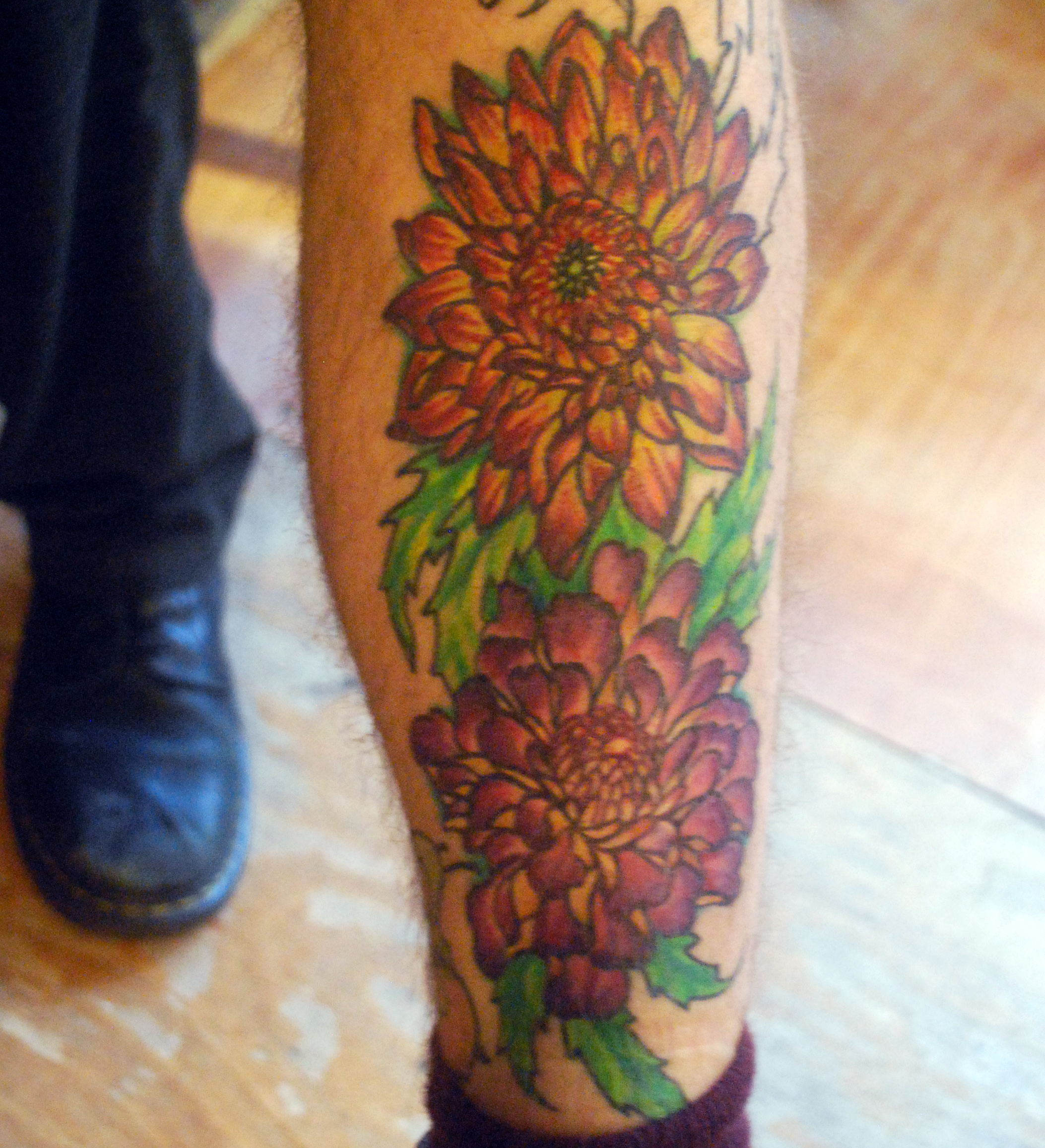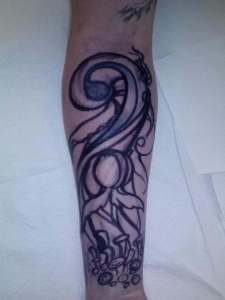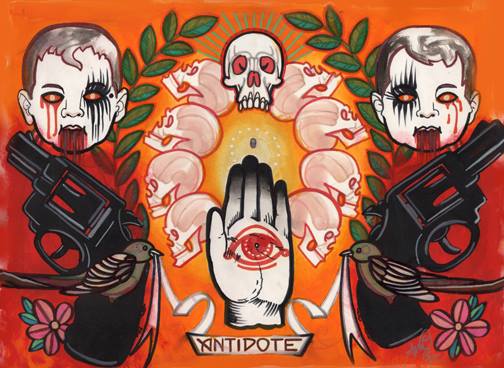four essential aftercare tips for fresh tattoos.
 Tattoos, just like a fur or a pair of old favorite boots, require some care to stand the test of time.
Tattoos, just like a fur or a pair of old favorite boots, require some care to stand the test of time.
Tattoos done before about 1990 have little hope of staying clear and unsullied by sun and weather and wear. The inks used before that time had many pigment ingredients which could react to sun exposure, and to the wearer’s own body fluids. These days, most tattoo inks used by professional artists are inert and hypo-allergenic, and at the very least should not react to the skin itself. They can still be faded and worn if not cared for properly. (Some people might still be allergic to certain inks, but it’s very rare.)
A tattoo is ink that is permanently set just under the translucent top layer of skin. This top layer is like an elastic window that you look through to see the ink. If the top layer is damaged or thickened or darkened, it becomes a dirty window. Age, sun exposure, and scars can all obscure a gorgeous tattoo and turn it into indecipherable mud. Also, the darker your skin, the more “tint” that window has.
- First and most destructive on the list of tattoo-destroyers is the sun. Just as a photograph left in the sun will fade over time, the pigments in a tattoo will fade. The pigmentation of skin is a poor defense, and putting sunblock on your tattoo will keep it looking fresh over the years. If you tan, try using a high SPF lip balm, and apply it just to the tattooed area. If you use a stick lip balm you can use it like a crayon and color in just the tattoo, letting the skin right up to it tan. This makes the tattoo look even newer next to the tanned area. If you will be out in the sun use a high SPF sunblock, even if your tattoo was done last year. The pigments can be faded even after the tattoo is long healed. Don’t start with sunblock until the tattoo is at least two weeks old.
- Second, wrinkles will obscure your tattoo, and may even distort it. Over the years, the cells in skin shift a bit and change relative position. As any dermatologist will tell you, avoiding sun exposure and staying hydrated keep wrinkles away. This will help your tattoo, also. Once the tattoo is applied it becomes part of your largest organ- your skin. What is good for your skin is good for your tattoo, too, so drink enough water. Moisturizing the tattooed area helps. Even years after the procedure, the area that was tattooed remembers the abrasion, and can get dehydrated more quickly than the rest of your skin. So be sure to continue moisturizing occasionally, even after the tattoo heals.
- Third, accidents happen. Scars that destroy tattoos are almost never intentional. The good news is that most scars can be tattooed over. Unless the scar is raised more than 1/4 inch from the surface, or is heavily textured, there are many tattoo artists that are willing to repair or retouch scars. If you’re planning on repairing a tattoo that’s been scarred over, try to allow at least six months for the scar tissue to “settle”. Use some light vitamin E oil or Emu oil on it from time to time and massage against the grain of the scar. This can sometimes help reduce the texture of the scar, and makes the tissue softer and easier to tattoo over.
- Last but not least, if your artist offers a free touch-up, take advantage of it within a few months. The best time to get tattooed is in the winter, when your new art won’t get exposed to the sun. But no matter when you get worked on, wait until after the summer sun has done its damage before you go back to get a touch-up. This way, the artist gets the satisfaction of a second look at your work, and you get to repair any damage the vacation did to your new ink.
When your artist gives you care instructions, follow them to the letter. Every artist uses different techniques to apply a
tattoo, and usually they know which healing procedure will work best in conjunction with it. Artists use such a variety of needle, ink, and bandaging material- as well as the variatons in YOUR body’s healing ability- that it’s impossible to give out one universal set of aftercare directions.
Don’t listen to your friends, other artists, or people you meet out and about. If you don’t trust the artist to know best, you should buy your tattoo from someone you DO trust. Pick an artist who you trust, and listen to them. They know how to help you heal your new work.
It’s OUR job to put the tattoo in just the right layer of your skin, just right. It’s YOUR job to do the other half- to heal your tattoo properly. Keep your tattoos clean while healing, and wash your hands before touching a fresh tattoo. Don’t wear tight things that will rub against or irritate your tattoo. Don’t swim or surf for the first few weeks. And most of all, let your tattoo get air.
A well-healed tattoo will make you happy for decades. Taking a few weeks to care for it properly is COMPLETELY worth it.
(written by me, originally published here)


 There are a lot of younger people today who are very interested in tattoos. In many cultures tattoos are used as a rite of passage from youth to adulthood, and in our Western culture it is no different. The lack of culturally-based rites of passage and tests of maturity leads many teenagers to seek alternate forms of self-challenge, and tattooing is currently high on that list.
There are a lot of younger people today who are very interested in tattoos. In many cultures tattoos are used as a rite of passage from youth to adulthood, and in our Western culture it is no different. The lack of culturally-based rites of passage and tests of maturity leads many teenagers to seek alternate forms of self-challenge, and tattooing is currently high on that list. In addition, a home environment contains many bacteria and other germs that could infect a fresh tattoo. Lack of proper knowledge about cross-contamination and bloodborne pathogens can put kids at serious risk when they get tattooed in a home environment.
In addition, a home environment contains many bacteria and other germs that could infect a fresh tattoo. Lack of proper knowledge about cross-contamination and bloodborne pathogens can put kids at serious risk when they get tattooed in a home environment.




 I don’t care if you are getting a “cool” tattoo. I don’t care if you know the etiquette or not.
I don’t care if you are getting a “cool” tattoo. I don’t care if you know the etiquette or not. I’m not a nurse or very good at babying people, but I’m willing to talk you through all the things you’re not sure about. I mean, I do have hard days or bad days. Of course, I’m human. But my worst day as a tattoo artist? Is better than my best day ever, before I was one. So I’m not going to freak out on you. I love my job and you are the job. You know?
I’m not a nurse or very good at babying people, but I’m willing to talk you through all the things you’re not sure about. I mean, I do have hard days or bad days. Of course, I’m human. But my worst day as a tattoo artist? Is better than my best day ever, before I was one. So I’m not going to freak out on you. I love my job and you are the job. You know?
 If you apprentice, you will be granted the respect of your peers, and have more access to knowledge, equipment, and skills than if you try to muddle through (dangerously) on your own.
If you apprentice, you will be granted the respect of your peers, and have more access to knowledge, equipment, and skills than if you try to muddle through (dangerously) on your own.










